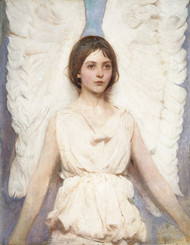Abbott Handerson Thayer (1849-1921)
Published by Therese Myles on 17th Sep 2019
Abbott Handerson Thayer was an American naturalist and teacher who painted portraits of mostly figures, animals and landscapes. He is also well recognized today for his paintings of ethereal angels, portraits of beautiful women, children, and delicate flowers. He was a devout New Englander who expressed himself mostly through works known as "soul painting". The exquisite beauty of his work was commonly sought after by collectors, and received a myriad of positive critique for his work.
Thayer is perhaps the most well-remembered immigrant Dublin artist of the early days of American art. His earliest works were generally commissioned by the extravagantly wealthy and was often called the "greatest portrait painter of the day". His present reputation is generally rested on his series of mythical and mystical winged figures, as well as his landscapes of Mount Monadnock.
Born in Boston in 1849, Abbott Handerson Thayer grew up as the son of a doctor with a horse-and-buggy service. Thayer left home in 1880 to study in France and returned to New York to paint and give painting lessons to the wealthy, gaining devoted acolytes left and right, due to his undoubted attractiveness to the protective aspects of some women. Through his teaching lessons, he received many things, like his summer house and studio and things of this nature. It was a good thing women felt the need to protect him, because he was diagnosed with bipolar emotions that sent him from one spectrum of emotion to the next at reckless abandon, described by himself as "exhilarated highs of emotion and messianic convictions", sometimes a man of ingratiating charm and grace, and generosity, other times a crazed lunatic. He constantly whistled Beethoven while he painted and sometimes amused himself by playing the violin.
Abbott Thayer was also never religious, and believed that churches were full of people who were hypocrites and narrow-minded. His work focused on an idea called Transcendentalism, which taught the permanence of God through nature, finding the beauty of the world a natural cloister of beauty, and therefore painted it as such. He personally found that art was impossible to not find beauty in, because every single painting made him closer to god. He also sought to deliver "unsullied purity and spiritual truth through his works of the highest human beauty found in the soul- but not angels. To him, they represented the infinite beauty of the "transient angelic figure of a woman."
Unfortunately for Thayer, his standards were far too high, and he was therefore forever doomed to fall short in all of his endeavors. His apartment was full of works in progress, and he constantly felt like he never finished any of his paintings, and he believed they had to be perfect because they were dictation from God, and was constantly plagued by his mental disorders, which became focal points for his art. His house was miserably cold, which eventually led to his death at the age of 72, in 1921. His ashes were carried to the heights of the trail he loved- Pumbelly Trail and dumped to leave a piece of him behind. His good friend John Singer Sargent remarked his discontent about his death, claiming that Abbott Handerson Thayer was among the best of them.

